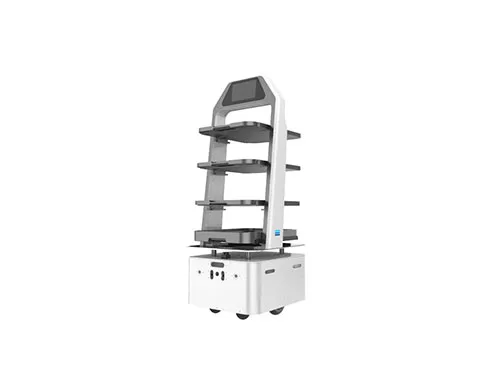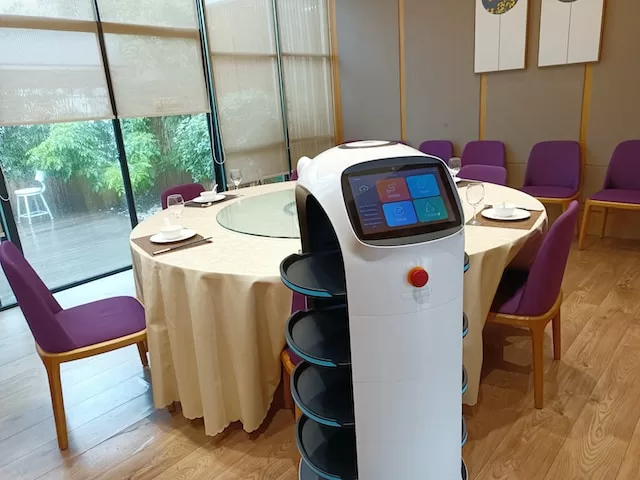One restaurant went from 14 to 4 employees in San Diego County.
Have you ever imagined walking into a fast-food restaurant and being greeted by a robot? Well, this may no longer be a thing of science fiction as fast food automation is quickly becoming a reality. Technological advancements have led to the development of fully automated fast-food restaurants that revolutionize how we order and prepare our meals. This includes the introduction of robots that handle everything from taking orders to cooking and serving meals. The future of fast food is looking brighter than ever.
One of the most significant developments in this area is the fully robotic McDonald’s restaurant. These restaurants are entirely staffed by robots, meaning customers can walk up to a kiosk, place their orders, and watch as robots prepare their meals. This streamlines the ordering process and reduces the need for human employees, leading to cost savings and increased productivity.
The benefits of automated fast-food restaurants are numerous. They offer faster service and shorter wait times as robots handle the ordering and cooking. This is especially beneficial for busy people or those with limited time for lunch breaks. Additionally, automated fast-food restaurants improve accuracy and consistency in food preparation, reducing the chances of errors and ensuring that each meal is prepared as ordered. This enhances the dining experience for customers and reduces food waste while improving efficiency in the kitchen.
In San Diego County, California, Mamma Ramona’s Pizzeria and Italian restauranthas incorporated technology to transform its workforce. The restaurant uses a Picnic pizza preparation robot, a Cuppone dough press, and a TurboChef rapid-cook oven to increase the pizza-making efficiency to over 100 pizzas per hour and reduce the workforce from fourteen to just four.
While these technological advancements create new business opportunities, they raise concerns about job losses and inequality.
The Profound Impact of Automation and AI on the Job Market: A Call-to-Action
According to areportby the Brookings Institution, urgent action is needed to support individuals at risk of losing their jobs due to the increasing influence of automation and AI in the labor market. Although several face high risks, the issue could affect anyone in San Diego County regardless of industry and background.
The report shows that the San Diego County’s San Diego-Carlsbad, California, area had 1,434,200 jobs when surveyed. The results indicate that 45% of employees’ tasks across all occupations within the metro are susceptible to automation. Moreover, thefindingsreveal that men, young workers, and underrepresented communities are more likely to work in automatable occupations.
Thereport also explores the intricate relationship between automation, artificial intelligence (AI), employment, and wages in the US. Automation has the potential to create and destroy jobs over time. Still, it also brings about displacement and wage reductions for certain workers, particularly those with low skills and education.
Furthermore, it warns that advanced robotics and AI will drive the next wave of automation, expanding the range of tasks machines can perform, which could affect many workers and exacerbate inequality.
For this reason, a proactive approach is necessary, wherein workers acquire new skills and education, and policymakers improve training opportunities, create sustainable employment, and provide wage support for affected individuals. The report underscores the significance of high-quality training in sectors with high demand and support for disadvantaged workers to complete their education.

On another note, thereportacknowledges that AI can also automate existing jobs, contributing to inequality and discrimination against workers. This raises concerns about the potential impact of AI on the workforce.
To address this issue, thereportsuggests that policymakers must carefully consider the economic implications of AI-driven technological change and make informed decisions to protect workers and consumers. Balancing progress and innovation in AI with safeguards against harm is crucial in ensuring a fair and equitable transition.
Artificial intelligence will significantly reshape the future of work in the United States. However, the consequences will vary across different regions and industries. Thishighlightsthe need for tailored approaches that consider these variations to mitigate adverse effects on jobs and wages.
By understanding the intricacies of automation and AI’s impact on the workforce, policymakers can develop comprehensivestrategiesthat foster economic growth while safeguarding workers’ well-being and promoting inclusivity. Ultimately, striking a balance between technological advancement and social equity is crucial in shaping a prosperous future of work in the United States.
The full article, ‘Automation and Artificial Intelligence – How machines affect people and places,’ is below.
Christmas in JulyHurry! 12% Off on July Christmas with Free Shipping! Use Code: XMASJULY
Not All Jobs are Equally Vulnerable to Automation
While it is true that certain professions, such as teachers and medical professionals, are less likely to be automated, the reality is that technology is advancing rapidly and is already starting to impact many industries. Low-skill jobs areparticularly vulnerableto automation. This is because they often involve repetitive tasks that can be easily automated.
Despite this, it is essential to note that automation does not necessarily mean theendof jobs. In many cases, specific tasks will be automated, freeing workers to focus on other areas that require human skills and expertise. For example, at Mamma Ramona’s pizzeria, automated technologies have reduced the need for manual labor in pizza preparation.
However, the restaurant still requires skilled workers to manage the technology, prepare and cook the pizzas, and provide excellent customer service.
Asautomationcontinues to advance, it will be necessary for workers to develop new skills and adapt to changing job requirements. This may involve learning to work alongside automated technologies or transitioning to entirely new roles less susceptible to automation.
Nonetheless, with the proper training and education, workers can remain competitive in an increasingly automated workforce.
Watch the video below for more info on Denny’s robotic server, ‘Maple,’ at a Northern California location.
The Impact of Technology Advancements on San Diego County’s Workforce
As technology advances, production and overseas operations can return to the US, which could positively and negatively affect San Diego County’s workforce. While local job opportunities may increase, businesses may opt for locations with lower distribution costs, leading to regional employment declines.
To address this, policymakers, businesses, and educators must collaborate to ensure workers have the necessary skills and support to thrive in an automated world. This may include investing in education and training programs that prepare workers for the changing job market and support those displaced due to automation.
It’s important to note that automation and technological advancements can lead to increased efficiency, productivity, and innovation. However, ensuring that workers are included and equipped with the tools and resources to adapt and succeed in a changing job market is crucial.
For example, in light of these findings, it is interesting to consider how innovations like the A302-A302D Fast Food Delivery Robot relate to the impacts of automation highlighted in the report. Fast food delivery robots are a prime example of how automation is being introduced into various industries.

Theserobotsare designed to autonomously deliver food orders to customers, reducing the need for human involvement in the delivery process. By using AI and automation technologies, these robots can navigate through crowded environments, avoid obstacles, and ensure efficient delivery.
While this innovation may lead to job displacement for some delivery workers, it also presents opportunities for increased efficiency and customer satisfaction in the fast-food industry.
The automation of Mamma Ramona’s pizzeria exemplifies how technology transforms San Diego County’s workforce. Policymakers, businesses, and educators must work together to address the challenges and opportunities automation presents. While automation can improve efficiency and productivity, it raises concerns about job losses and inequality. Ensuring workers have the skills and support required to thrive in an increasingly automated world is crucial.

